In the ever-evolving realm of education, AI has emerged as both a beacon of hope and also inevitably, a source of concern. Excitement fills the air as optimists envision AI-driven classrooms with handy AI assistants and tools creating personalized learning experiences and unprecedented educational advancements. However, amidst the excitement, some educators find themselves grappling with anxieties, fearing the unknown consequences and that AI might bring.
We noticed despite the buzz and rich discussions surrounding this topic, there is (unfortunately), a scarcity of content and resources explaining AI terminologies in education and guiding educators to make wiser decisions in their teaching.
Our A-Z Guide to AI in Education is here to empower you with the knowledge and actionable solutions to embrace AI in your teaching journey confidently, from the AI terminologies you need to know, best AI tools available and examples and applications, to everything you need to know about ChatGPT, future and predictions of AI in education from experts, strategies and guidelines to be a future-ready teacher, and many more.
Created by education professionals, this guide serves as a one-stop resource, trends and information for all things AI for teachers and educators. Whether you are an enthusiastic early adopter, a cautious observer, or simply ambivalent, we have got you covered. 🌟
A-Z Guide to AI in Education 2024
Get access to the latest trends, tips, tools, and everything you need to know about AI in Education now.
AI in Education Guide
AI and Generative AI
What is AI?
In layman terms, Artificial Intelligence (AI) refers to the machine’s ability to simulate human cognitive functions and perform tasks that typically require human intelligence, including perception, reasoning, learning, problem-solving, and understanding natural language. As for AI in the education sector, AI has been used to perform a wide range of tasks from lesson planning and admin tasks automation, to personalised learning and even surveillance.
AI is powered by algorithms and data. Machine learning is a field of AI that enables machines to learn from vast amount of data and make predictions and recommendations over time without explicit programming instruction. Deep learning, on the other hand, is a subset of machine learning, which uses artificial neural networks (algorithms and computing units that take inspiration from a human brain) to mimic the learning process of the human brain, and has proven especially effective in various applications such as image recognition and natural language processing (NLP). NLP is a machine learning technology that gives machines the ability to process, interpret and understand human languages.
Types of AI
There are different types of AI, but they can generally be categorized as:

- Narrow or Weak AI: Narrow AI is designed to perform a specific task within a limited domain. They excel at particular tasks like playing chess, answering questions based on input, but they lack general intelligence. A famous example of narrow or weak AI is AI-powered chatbots like ChatGPT, Bing AI and Google Bard.
- General or Strong AI: General AI are machines with human-level intelligence that can perform any intellectual task that a human can do. In other words, a strong AI can learn and adapt like a human do. This kind of AI remains theoretical and is yet to be achieved.
AI has made progress in leaps and bounds in recent years, impacting various industries like healthcare, media, transportation, and of course, education. And especially with the ChatGPT becoming an internet sensation overnight in November 2022, different kinds of AI tools cropped up like mushrooms after the rain. And a specific kind of AI caught the attention of the world – generative AI, a kind of narrow or weak AI that has become people’s favorite. We will be discussing what’s so great about this type of AI in the next section.
What is Generative AI? What’s With the Hype?
Generative AI, or Generative Artificial Intelligence in short, is a class of narrow/weak AI models and algorithms designed to generate new content, including images, text, audio, videos, synthetic data and more based on the data they are trained on. They are unlike traditional AI models that are used for classification or prediction tasks.
Generative AI models typically are built using deep learning architectures, and these AI models can be trained on large datasets and then fine-tuned for specific tasks. As such, they can generate high quality and coherent content with innovative variations.
One of the most prominent applications of generative AI is in the field of NLP. Generative AI models like OpenAI‘s GPT (Generative Pre-trained Transformer), where ChatGPT is built on, are trained using vast amounts of text data and can then generate human-like responses that are coherent and contextually relevant to the user inputs.
The recent hype around generative AI has been driven by its simplicity, intuitiveness, as well as its ability to create high-quality content including text, images, audio and videos in a matter of seconds. As such, we have also observed an increasing trends among educators adopting generative AI tools to create more personalized and engaging lessons, as well as assist them in the creation of teaching materials quickly and easily.
Here is a list of examples of Generative AI tools commonly used in education:
- Text generation tools: ChatGPT, Bing AI, Google Bard, Jasper AI, Copy.ai, Anyword
- Image generation tools: Dall-E 2, Midjourney, Stable Diffusion, Bing Image Creator
- Voice synthesis tools: Descript, Speechify, Listnr
- Video generation tools: Pictory AI, Synthesia, DeepBrainAI
- Presentation making tools: Presentations.AI, Decktopus AI, Slidesgo
- Quiz generation tools: ClassPoint AI, QuizGecko
➡️ More generative AI tools and ChatGPT alternatives for educators
History of AI in Education
Generative AI technology, or AI technology in general, it should be noted, is not brand-new. Let us now dive into the history of AI in education till date.
The history of AI and generative AI dates back several decades. Let us take a journey through the key milestones and developments of AI in education!

Here is a summarized version:
- Early Research (1950s-1960s): The term “artificial intelligence” was coined, early natural language processing programs like ELIZA were created, and the first Intelligent Tutoring System (ITS) called “SAINT” was developed.
- System Formation (1970s-1980s): Introduction of Bayesian networks causal analysis by Judea Pearl and the first publication of the International Journal of Artificial Intelligence in Education was released.
- Machine Learning and NLP Advancements (1990s-2000s): The defeat of world chess champion Garry Kasparov by IBM’s Deep Blue marked the beginning of AI in games and simulations. The 2000s also witnessed the rise of Massive Open Online Courses (MOOCs). A couple other NLP-powered AI applications for assessment and learning like Rosetta Stone Language Learning Software, Turnitin and ALEKS were introduced.
- Chatbots Emergence (2010s): AI achieved significant milestones in generating human-like text (GPT-2 and GPT-3), generating images from texts (DALL-E and Stable Diffusion). AI tutoring systems like “Mika” demonstrated promising learning outcomes, and chatbots became prevalent for language learning support.
- Popularisation of AI (2020s): With the wide accessibility of especially generative AI tools, AI has been applied to streamline administrative tasks and improve learning in various education contexts.
How AI is Used in Education in 2024
As we have seen, AI has made remarkable strides over the years. With AI technology’s ongoing evolution, its influence on education is poised to grow even more extensively. Having journeyed through the history of AI, let us now delve deeper into the present and beyond, and look at the primary applications and examples of AI in education for 2024 and beyond.
👩🏫 Classroom AI in 2024

Classroom AI refers to the use of AI technologies and tools in various educational settings to increase teachers’ efficiency and enhance the learning experience for students. More and more teachers are leveraging Classroom AI to revolutionize traditional teaching methods and stay ahead of the curve.

51.13% of teachers worldwide use AI frequently in their teaching (at least once per week), and the rest do not use it on a regular basis, or only when necessary.
ClassPoint Survey, 2023
By leveraging classroom AI, educators can optimize their teaching strategies, cut down time on administrative tasks, and foster a more engaging and innovative learning environment for students.
How is AI being used in education?
Here are 3 main ways you can use AI to transform your classroom:
1. Personalized learning: Use AI technologies to customise learning materials based on individual students’ learning patterns, needs, strengths and weaknesses to unlock their full potentials.
2. Classroom management: Use AI technologies to assist you in classroom management and administrative tasks like scheduling, grading, lesson planning and more.
3. Student analytics: Use AI technologies to analyze your student classroom performance to identify students who need extra attention and require intervention to boost academic outcomes.
🔥 Explore more ways you can apply AI in your teaching, and read our Ultimate Guide to Classroom AI in 2024 for a comprehensive guide to the tools, resources and best practices to implement AI like a Pro in your classroom teaching in 2024! If you are a higher education teacher or lecturer, check out our exclusive guide for AI for Higher Education.
Let us now explore the most popular AI examples and tools teachers are currently using to enhance their classroom teaching:
🤖 ChatBots
It is undeniable that chatbots like ChatGPT, Bing AI, and Google Bard have revolutionized the educational landscape and earned admiration from teachers worldwide. While we still face some skepticism and hesitance about these AI chatbots, teachers worldwide are beginning to appreciate the versatility and efficiency of these chatbots, as well as adapting them to their day-to-day teaching life. The fact that these chatbots are designed to interact with users in natural language and are capable of producing innovative output from simple input really removes the prerequisite of being tech-savvy in creating innovative lessons. Now anyone can use these chatbots as assistants in a wide range of tasks from lesson planning and brainstorming, to feedback generation and personalized learning recommendations.
We will first explore ChatGPT, the chatbot that took the world by storm and how you can apply it to your education to transform it for the better. We will also provide you with sample prompts you can copy and use straight away!
ChatGPT as A Diligent Admin Assistant
Below is a list of ways ChatGPT can help you with admin work to immediately save 30-40% of your time performing admin tasks as a teacher:
1. Use ChatGPT to manage classroom logistics and announcements including scheduling and reminders, drafting announcements and even setting up appointments.
ChatGPT prompt to use: Can you help me draft a message to inform my students’ parents about [event]. Include details such as [details].
2. Use ChatGPT to facilitate communication with your students.
ChatGPT prompt to use: “I noticed some of my students have difficulty approaching me with questions or concerns. Can you suggest effective strategies to improve communication between me and my students?"
3. Use ChatGPT as a college application advisor.
ChatGPT prompt to use: “A student of mine is applying for the [program] at [university]. Can you provide guidance on the application process, essay prompts, and tips for crafting compelling personal statements?"
- Use ChatGPT to write recommendation letters.
ChatGPT prompts to use: “Write me a college admission recommendation letter for my student [student name] applying for [programme] at [university name]. Include the following information about the student [details in curricular and extracurricular performances].
- Use ChatGPT to help you organize information.
ChatGPT prompt to use: "Help me organize [information] into [desired format]."
ChatGPT as An Ingenious Lesson Planner
Below is a list of ways ChatGPT can help you with lesson planning to save you hours of work so you can focus on what matters most – teaching and engaging with the students!
1. Use ChatGPT to research and gather relevant content and links for your lessons.
ChatGPT prompt to use: "Provide me with reliable sources and information on the topic of [topic] for my upcoming [subject] lesson."
2. Use ChatGPT to structure a detailed lesson plan.
ChatGPT prompt to use: "Can you provide me with a lesson plan template or a suggested outline for teaching the topic of [topic] to [grade level] students?"
3. Use ChatGPT to generate discussion and lesson prompts.
ChatGPT prompt to use: "I need some thought-provoking discussion prompts for my lesson on [topic]."
4. Use ChatGPT to create instant worksheets and exercises.
ChatGPT prompt to use: “Create a worksheet on [topic] with a list of [number] exercises related to the [learning objectives].”
ChatGPT Cool Tricks
Here is a list of cool things you never expected ChatGPT could do in your lessons:
1. Use ChatGPT to teach in the style of an absent teacher.
ChatGPT prompt to use: "I need guidance on how to continue the lesson on [topic] left by another absent teacher. He/She teaches in [briefly describes the teaching style of the teacher]. Can you provide suggestions on how to teach in his/her style?”
2. Use ChatGPT to create personalized learning plans for your students with special needs.
ChatGPT prompt to use: “Can you help create an individualized lesson plan (IEP) for a student with [special need]?”
3. Use ChatGPT for interactive storytelling.
ChatGPT prompt to use: "Let's create a story together! Start with an opening line, and I'll respond with the consequences. We can continue the story by taking turns."
4. Use ChatGPT to build an interactive classroom game from scratch.
ChatGPT prompt to use: "Design me an educational game on [topic]. Describe the rules, objectives, learning outcomes, and gameplay mechanics."
5. Use ChatGPT to create ready-made slides in PowerPoint.
ChatGPT prompt to use: "Write me VBA PowerPoint codes on [topic]. Make it [number] slides."

➡️ Want more ChatGPT prompts and use cases? Read this 100+ ChatGPT Prompts for Teachers.
➡️ Have more queries about the use of ChatGPT in the classroom? Read this Ultimate ChatGPT FAQ for teachers that covers all possible queries and qualms you have about ChatGPT.
⚔️ The Battle of ChatBot Giants: ChatGPT vs Bing AI vs Google Bard
If you have used ChatGPT, you are likely acquainted with many other AI chatbots that are competing for attention, including Bing AI and Google Bard. We will compare the three AI chatbots supported by the largest browsers and technology companies: ChatGPT, Bing AI, and Google Bard. ChatGPT was released in November 2022 and quickly became an internet sensation. Microsoft then launched an AI-powered version of its Bing search engine called Bing AI. And finally, Google also recently launched its own chatbot called Google Bard, which is still in the experimental phase.
Here is a detailed comparison of these 3 AI chatbots, so you can make your own verdict on which tool to go for in your classroom teaching based on your needs:
| ChatGPT | Bing AI | Google Bard | |
|---|---|---|---|
| Technology | GPT (Generative Pre-Trained Transformer) technology by OpenAI. | GPT (Generative Pre-Trained Transformer) technology by OpenAI. | LaMDA (Language Model for Dialogue Applications), trained using literature and poetry data. |
| Accuracy | Rather accurate, but information is only up to September 2021. | Up-to-date information. | Not accurate on facts and maths. |
| Creativity | Most creative and original. | Has a “creative” mode. | Not as creative, can involve repetitive terms. |
| Speed | Fast. | Slowest of the 3. | Faster than the free version of GPT-3.5 model. |
| Text Output Detail | Detailed | Less detailed, but produce formatted answers. | Least detailed. |
| Generate Images | No, not without plugins for GPT-4. | Yes | No. Soon to be available. |
| Internet Access | No, not without plugins for GPT-4. | Yes – and this allows Bing AI to give you more accurate results, as well as sources to the results it fetches. | Yes. |
| Languages | More than 80 languages. | More than 100 languages. | Soon to support more than 100 languages. |
| Price | GPT-3.5 model is free to use, but GPT-4 model can only be access with a ChatGPT plus account which costs $20/month. | Free for now. | Free for now. |
In summary:

🦾 Non-Chatbot AI Tools
Now let us venture outside of these 3 chatbot giants, to explore alternatives to ChatGPT, Bing Ai and Google Bard. These non-chatbot AI tools are powered by generative AI technologies that are used to power AI chatbots. These non-chatbot AI tools are also powered by generative AI technologies, similar to those used in AI chatbots. The only difference is that they are specifically trained to perform distinct purposes and tasks, some of which are tasks that AI chatbots are not trained to perform.

AI Admin Assistants
Running a classroom demands significant effort in handling various administrative tasks, from managing attendance records, organizing lesson materials, to grading assignments, often leaving teachers with limited time to concentrate on their students’ learning and growth. However, there are AI tools specialized in assisting teachers in transforming their administrative workflows. We will explore some of the best AI admin tools for teachers in 2024 and how you can use them to streamline your administrative tasks as a teacher.
1. Automate admin tasks: Zapier
Zapier allows teachers to automate repetitive tasks such as grading assignments, managing certification, making announcements or sending email reminders to students. The best part is, Zapier connects to different software tools so that you can easily automate a variety of tasks on existing tools you are using, including Google Chat, Trello and many more.
2. Organize virtual classrooms: AI-Powered Google Classroom
Apart from creating and distributing assignments and tracking attendance, to managing assignments to providing real-time feedback, teachers can now receive teaching hints and guidance, as well as organize classroom assessments by semesters and terms with the help of new AI features in Google Classroom.
3. Access to personal teaching assistant: Khanmigo
Khanmigo is a teacher’s best personal assistant on a wide range of admin and teaching tasks. It can help teachers with lesson planning, tracking student progress, as well as curate tailored teaching paths for the students.
AI Assessment Graders
With the latest developments in NLP and generative AI, grading stacks of assignments and assessments is no longer a costly and time-consuming nightmare. Let us share with you the best AI automated grading tools available in 2024 to help you take the grading burden off your shoulders.
1. Automated grading and personalized feedback: Gradescope
Gradescope can accurately assess student responses, and provide quick and precise evaluations of student submissions based on the rubrics and grading criteria you define. Gradescope is trained to grade a wide variety of subjects from all education levels from geography and science to engineering and psychology.
2. Automated multiple-choice grading: SmartGrade
Teachers can create multiple-choice question exams and receive analytics of the student performance through a simple act of scanning the answers using the SmartGrade app.
3. Diverse assessment generator and automated grading: Formative AI
Not only does Formative AI help grade student work and provides real-time personalized feedback, as well as identifies areas of strengths and weaknesses, it also helps teachers streamline the assessment creation process with a variety of assessment templates to choose from.
AI Detectors
Another important aspect of grading is plagiarism checking. Plagiarism checking is an integral part of grading to maintain academic integrity and honesty, as well as promote authenticity and originality of thoughts for intellectual growth among students. There are plenty (in fact, too many) AI detectors available currently, and to save you time, we have compared and selected the 9 best free AI detectors for teachers like you. On the other hand, students could also benefit from AI-powered plagiarism checkers to help them maintain academic integrity.
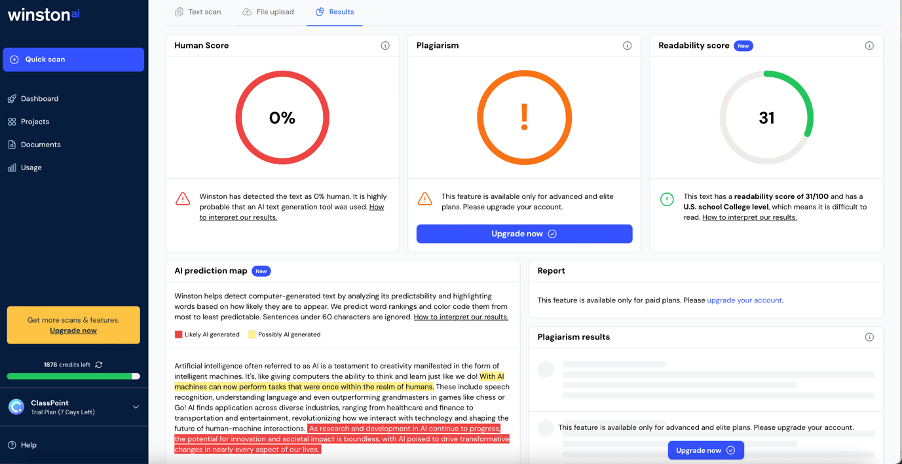
Here are the top 3 we voted for:
1. Most accurate: Winston AI
Arguably one of the best AI detectors in terms of accuracy. Unlike many other free AI detectors, it did not incorrectly label any human text as AI-generated, and vice versa. It also provides a clear explanation, report, as well as document upload feature. However, Winston AI is a paid tool. Its free trial version only lasts for 7 days and is capped at 2000 words or credits.
2. Includes plagiarism checker: Turnitin
Most if not all teachers are familiar with Turnitin. Turnitin has recently launched its AI detector specifically trained to detect AI-generated content. It is trained to detect content from the GPT-3, GPT-3.5 and GPT-4 language models, including ChatGPT. Teachers can use it to detect AI-generated content from a wide variety of languages and subjects.
3. Best for Report: AI Detector Pro
AI Detector Pro is one of the many free AI detectors that actually provide a report indicating which part of the texts is likely AI-generated. Not only it detects content from website URLs, it also provides users with 30 additional tools which include functions like text cleaner, word density counter, and many more for researchers, developers and content writers.
➡️ Check out these 6 other alternative AI detectors to help you manage your student work more effectively in the current age of widespread AI advancement and accessibility.
AI Image and Video Generators
With the power of generative AI, teachers can now utilize AI for image and video generation to enhance their visual teaching materials and create more engaging, accessible lessons. The popular text-to-image generators in the market currently are Dall-E 2, Midjourney, Stable Diffusion and Runway.
However, these are expensive options that are tailored more towards designers and artists. For more educator-friendly options, we recommend Bing Image Creator, Leonardo.Ai and Craiyon.

If you are an educator who likes to create posters or visual materials in your class, you should try Canva Magic Design, a photo editor with no learning curve. Simply upload any photo of your choice and Canvas Magic Design tools will provide a wide range of edited and ready templates for you to choose from!
As for video generators, we recommend the following:

1. Turn lessons into videos: Pictory AI
You can turn any ordinary lessons into engaging videos with Pictory AI’s ability to create videos from any content, article or script.
2. Edit videos without video editing skills: Descript
Descript allows you to easily edit your videos effortlessly without any video editing skills, just by using auto-transcription. This is super handy for teachers who want to create online videos or content to supplement their teaching.
3. AI-dubbing: Speechify
Speechify allows you to create multilingual video content in only a few clicks with dubbing, so you can reach more students with your videos.
AI Lesson Planners
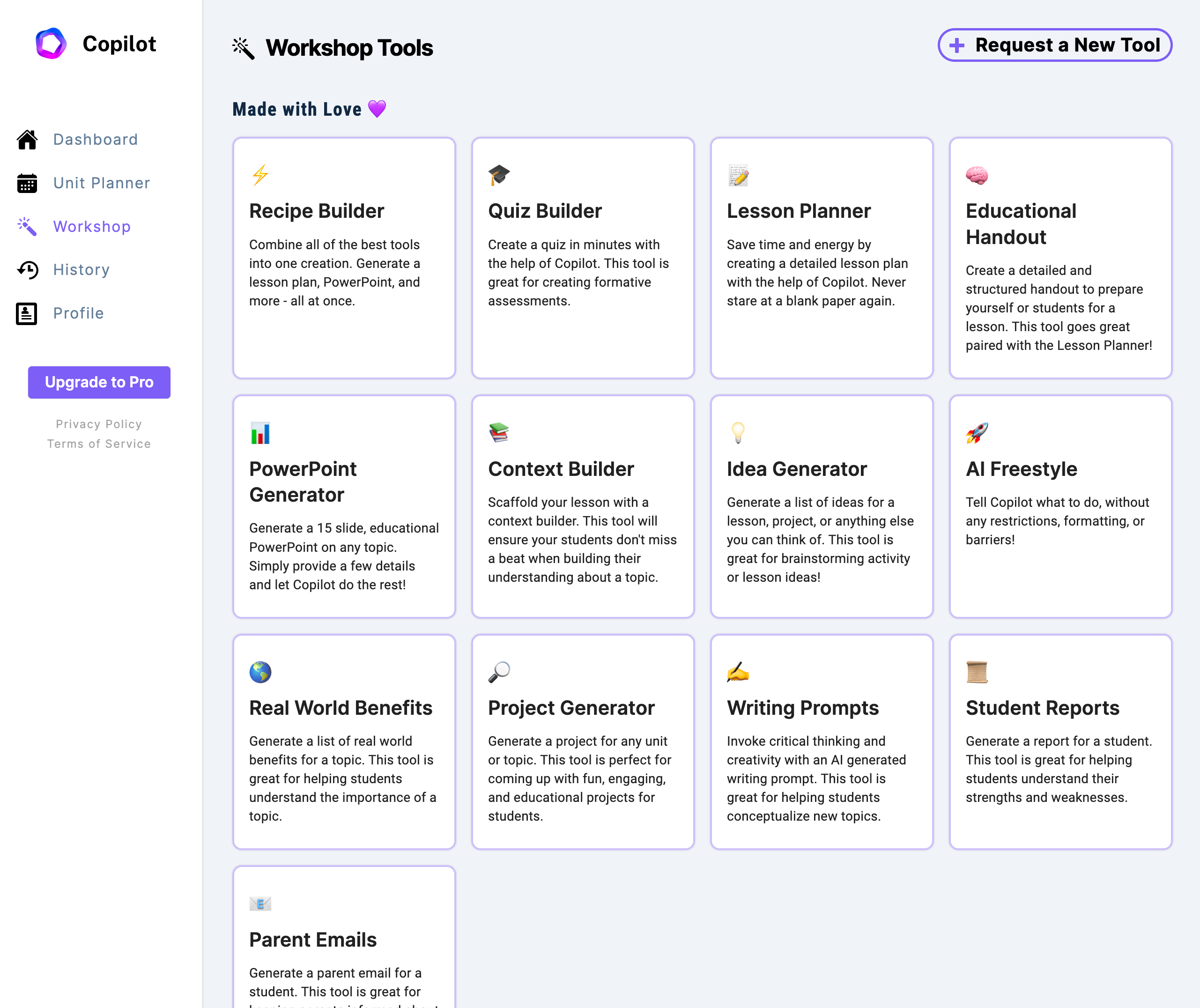
Lesson planning is a crucial part in teaching to ensure that teaching objectives are met and are reflective on student performance. In the past, lesson planning is done manually with teachers drafting out the lesson outlines, objectives, activities and prompts from scratch. Now with a wide array of AI tools for lesson planning available, teachers can now plan their lessons without breaking a sweat!
1. Plan more creative lessons: Education Copilot
Generate structured lesson plans and lesson materials that fits your teaching styles and student’s needs by simply telling the AI.
2. Create Course Material, videos, and interactive questions: Nolej
Nolej generates interactive courses, videos, and assessments to be embedded in your favorite Learning Management System (LMS). Or you can simply convert any existing content into course material in seconds!
3. Plan well-thought lesson outlines: LessonPlans.aI
Developed by teachers, for teachers, LessonPlans.AI specializes in creating detailed lesson outlines for any lessons, which include any warmup activities and instructional material you need.
AI Quiz Makers
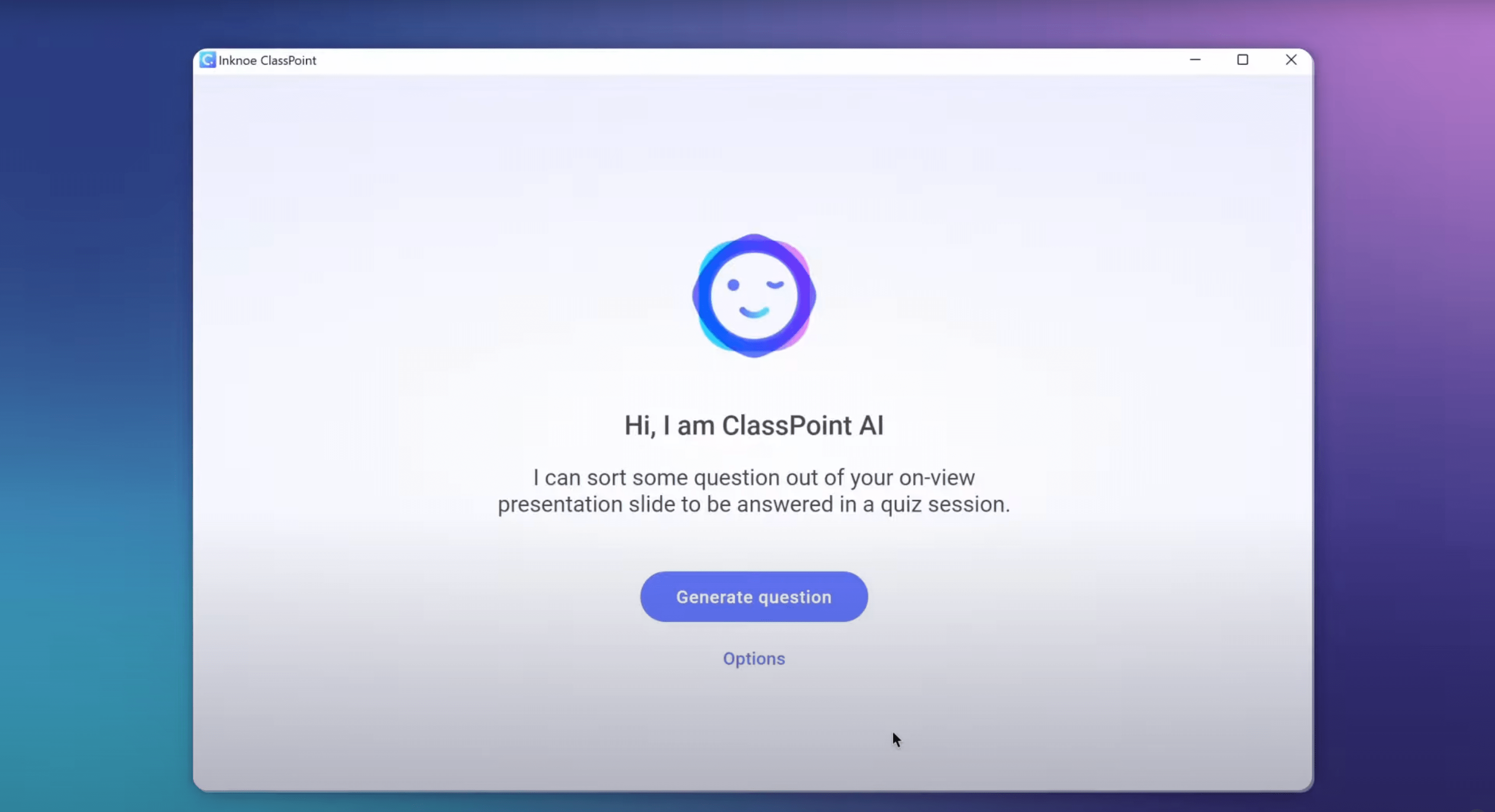
Preparing quizzes and assessment questions is a teacher’s regular task to assess student performance and identify areas for improvement. However, traditional quiz generation methods are tedious and time-consuming. With the current AI technologies in 2024, teachers can now rely on AI-powered quiz makers to automate the process of quiz generation. We have tried almost all the quiz makers available, and carefully selected the 3 you really need:
1. Automated quiz generator based on PowerPoint Slides: ClassPoint AI
Powered by OpenAI, ClassPoint AI scans your PowerPoint presentation slides and curates accurate questions based on the slide content. These questions are fully customizable, allowing you to choose different question types, languages, and Bloom Taxonomy levels according to your teaching goals and needs. This is super convenient for teachers who use PowerPoint in their teaching – in only a single click, teachers can turn their teaching materials into interactive questions and assessments!
- 💡 How? Refer here for an in-depth tutorial on how to create an AI-generated interactive quiz in PowerPoint in a few clicks! All you need is PowerPoint and ClassPoint!
- 👾 You can also easily turn your quizzes into a gamified experience using ClassPoint’s built-in gamification features.
2. Online quiz generator: QuizGecko
Similar to ClassPoint AI, QuizGecko utilizes AI to automatically generate quiz questions from teaching materials and content. However, unlike ClassPoint AI, QuizGecko is not integrated with PowerPoint, and the questions it generates are not immediately interactive within a classroom setting. Nevertheless, QuizGecko offers flashcard options, which provide teachers with additional tools and resources for exam revision purposes.
3. AI-assisted assessment platform: ExamSoft
ExamSoft is tailored towards educators looking for a tool to generate exam and test questions, as well as target practice exercises automatically for students. It also includes features that track and analyze student performance and tailor questions to ask that will most benefit their learning.
➡️ We have also reviewed and carefully selected a list of top 5 AI quiz generators here if you would like to explore alternative options.
AI Presentation Makers
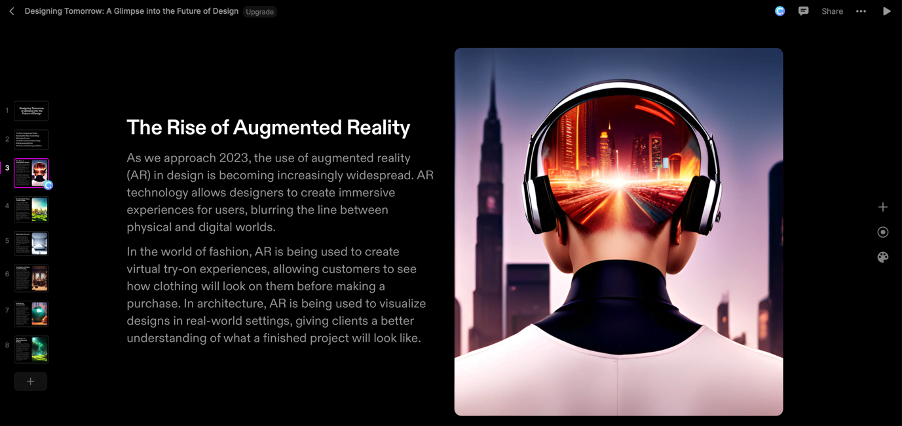
A common struggle that we all face as educators is spending an eternity working on our teaching slides. It is time to break free from the presentation making prison with the following best AI presentation makers in 2024 that can help you design presentation slides in seconds!
The majority of AI presentation makers possess the capability to analyze input prompts, produce pertinent content, propose suitable layouts and designs, and offer customization options. Some of these tools even boast advanced AI functionalities like creating images and quizzes from text input and converting documents into presentations, as we will explore. Utilizing AI PowerPoint Generators enables users to craft impressive presentations in a significantly shorter time, empowering them to concentrate on delivering captivating and impactful messages to their audience.
Let us reveal our top 3 favorite AI PowerPoint generators:
- Tome AI – Best for Aesthetic Slides
Generate aesthetically pleasing PowerPoint slides with just a simple text input. The slides generated are fully editable, which means, you have the full freedom to change the theme, style, font and add multimedia from stock library or using the in-built text-to-image generator in Tome AI. Moreover, Tome AI offers seamless integration with collaborative work platforms such as Figma, Airtable, Miro, and Looker, making it ideal for cross-platform collaboration.
SlidesGo is a renowned catalog site for presentation templates. You can use SlidesGo together with its sister project, WePik to create AI-generated slides on the fly. A wide range of customisation abilities are available, and SlidesGo is one of the best catalog site for presentation makers for a reason – they have also partnered with Freepik, Pexels and Flaticon for the users’ convenience to access vectors, stock images and icons while designing their slides!
- ClassPoint AI – Best for Interactive Quiz Slides
On top of its ability to generate quizzes, the AI is also able to turn these quizzes into slides that can be immediately integrated in your PowerPoint slides deck, simply using the “insert as slide” feature of the tool. The best part is, you can tailor the cognitive complexity of your slides by utilizing Bloom’s Taxonomy levels.
Below is an easy 3-step-process to generate an interactive quiz slide instantly using ClassPoint AI:
Step #1: Open your PowerPoint slides.
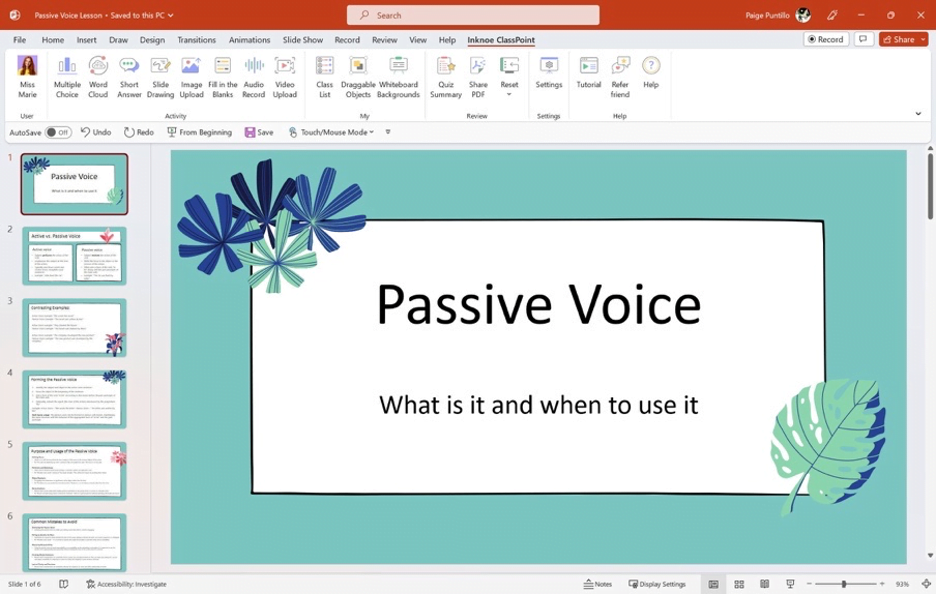
Open any existing PowerPoint slides.
Step #2: Click on “ClassPoint AI” in slideshow mode. The AI will then scan your PowerPoint slide and generate contextually relevant questions based on your slide content.
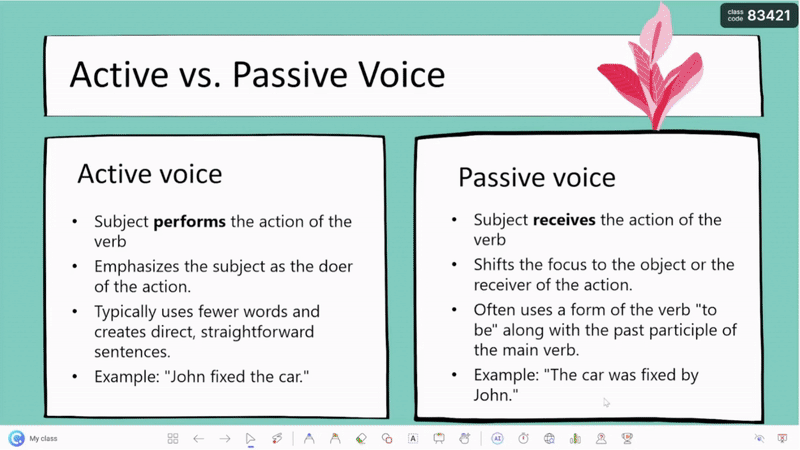
The AI will then scan your PowerPoint slide and generate contextually relevant questions based on your slide content. Note: the slide needs to have at least 2 words for ClassPoint AI to work.
Step #3: Click “save as slide” and start running the quiz!

Save the question generated by ClassPoint AI or “generate another” if you are not satisfied with the question generated. If you are happy with the question, click “save as slide” and run the quiz by clicking at the blue ClassPoint button created. Invite your students to join the quiz at www.classpoint.app to start collecting responses.
➡️ More on how to run an interactive quiz on PowerPoint with ClassPoint.
➡️ If you are a PowerPoint user, here is a list of the best free AI PowerPoint generators in 2024, and 8 additional ways you can use AI to enhance your PowerPoint presentation!
🧠 Pro Tip: You can use ChatGPT to create a ready-made PowerPoint slide deck for you using prompt #61 on the list of 100+ ChatGPT examples for teachers!
Choosing the Right AI Tools
For your convenience, we have cherry-picked the 7 best AI tools for teachers in 2024.
💯 Top AI Tools Recommended by Teachers
Here we have also meticulously compiled a list of AI tools from our survey with educators worldwide, showcasing the most recommended solutions, utilized by teachers to enhance teaching and learning experiences.
- Time-management and scheduling assistant: Reclaim.ai
- Intelligent, AI-powered PDF conversations: AskYourPDF
- Accurate AI translator: DeepL Translate
- AI Chatbot: Neuroflash (capable of plagiarism check, generating images, comes with prompt templates, and many more features)
- Learning Copilot: Monic.ai (capable of converting teaching materials into assessment, summaries, study guides, and more resources)
- Video generator from audio or text: Steve.ai
- AI writer and paraphraser: Writesonic
- AI quiz generator: Conker
✅ Criteria for Selecting AI Tools
With the never-ending sprouting of new AI tools, it is important for teachers to know the best criteria to look for when it comes to picking any up and coming AI tools.
Seeks tools that tick the following boxes:
| ✅ Bias and Fairness | Have undergone bias testing and are designed to promote fairness and inclusivity. |
| ✅ Data Privacy and Security | Adhere to data protection regulations and employs robust encryption and storage methods. |
| ✅ Customization and Adaptability | Customizable and versatile enough to meet different classroom needs and curriculum. |
| ✅ Integration and Compatibility | Offer seamless integration with your existing technology infrastructure, such as learning management systems or other educational platforms used in your institution. |
| ✅ Scalability | Scalable for multiple classrooms and institutions. |
| ✅ Support | Provide adequate customer support. |
| ✅ User Experience | User-friendly and intuitive to use, without requiring technical expertise or training. |
| ✅ Accessibility Features | Offer accessibility features, such as closed captions, text-to-speech, and other assistive technologies, to cater to students with diverse learning needs. |
| ✅ Cost | Cost-effective based on your budget. |
| ✅ Research and Evidence | Supported by research, case studies and evidence in their effectiveness in educational settings. |
| ✅ Pedagogical Alignment | The final, and perhaps the most important of all, use AI tools that align with your teaching philosophy, goals and pedagogical approach. The tool should complement your teaching methods and enhance the learning experience for students. |
By considering these tips and criteria, you can make informed decisions and select AI tools that align with your educational objectives and enhance the teaching and learning experience in your classroom.
➡️ Ready to start implementing the AI tools you have selected in their classroom teaching? Check out these 5 simple steps.
Benefits and Harms of AI in Education
Benefits of AI in Education
Now that we have discussed a wide range of classroom AI tools teachers can implement in their classroom teaching in 2024, it has become clear to us the benefits AI bring to the realm of education.
So, how will AI impact education? Here is a quick summary:

1. ChatBots as Teachers’ Personal Assistants
Chatbots like ChatGPT offer teachers instant support and time-saving benefits on a wide range of tasks from lesson planning and curating personalized learning experiences, to making games, and serving as a virtual tutor. They enable teachers to scale instructional support, promote inclusivity, and contribute to more dynamic and supportive learning environments.
2. Streamlined Admin Workflows with AI Admin Assistants
AI admin assistants offer valuable benefits to teachers by streamlining administrative workflows. With the ability to handle tasks such as managing attendance records, organizing lesson materials, and grading assignments, these specialized AI tools free up more time for teachers to focus on their students’ learning and growth.
3. AI Assessment Graders to Remove Tedious Grading Tasks
AI assessment graders help teachers reduce the burden and time spent in grading assignments. Some of these tools also provide real-time personalized feedback to students, helping teachers to pinpoint the areas of weaknesses of their students more effectively.
4. AI Plagiarism Checkers to Promote Academic Integrity
AI plagiarism checkers help teachers maintain academic integrity and honesty, as well as promote authenticity and originality of thoughts for intellectual growth among students.
5. AI Image and Video Generators for More Engaging Lessons
AI image and video generators help teachers easily create visually appealing teaching materials to make learning more interesting and exciting.
6. No More Planning from Scratch with AI Lesson Planners
AI lesson planners help teachers drat lesson outlines, objectives, activities and prompts effortlessly, tailored to individual teaching needs.
7. Instant Quiz and Questions Generation with AI Quiz Makers
Teachers can now save time in preparing quizzes and assessment questions to assess student performance and identify areas for improvement with AI quiz makers, simply by turning existing content into quizzes and exercises.
8. Destroy Slides Creation Nightmares in 1 Click with AI Presentation Makers
The creation of teaching slide decks has never been easier with AI presentation makers that can help teachers create aesthetically pleasing slides in seconds.
All these essentially entail more time freed up for teachers to focus on what matters most in education – teaching, inspiring and engaging with the students themselves!
Harms of AI in Education
However, widespread accessibility of AI tools also implies that educators are not immune to a multitude of concerns regarding the applications of AI. As educators, we should also keep in mind the potential dangers of AI in education, and the best ways to deal with these AI risks and harms:
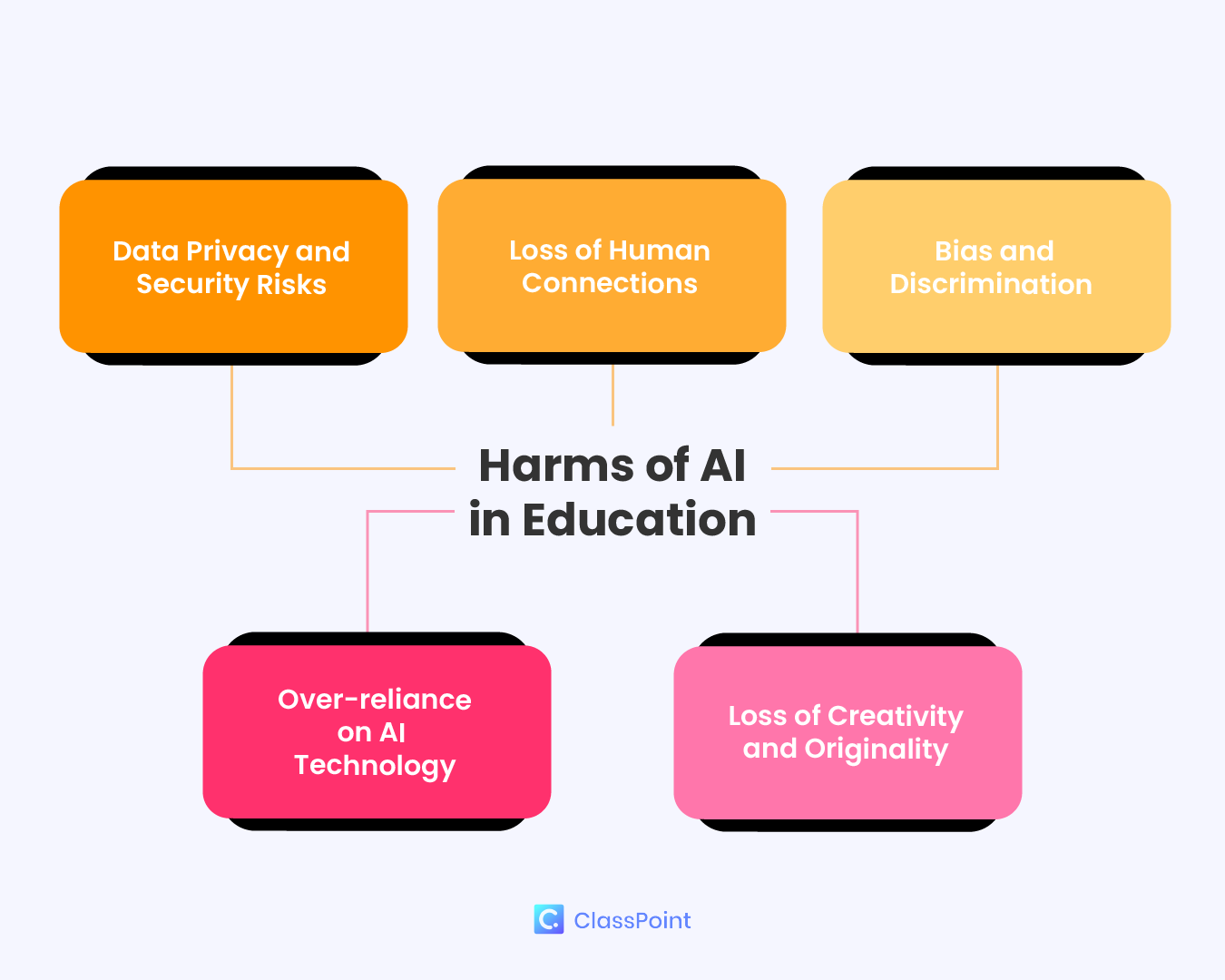
1. Data Privacy and Security Risks
Most AI-powered platforms and tools collect vast amounts of student (and teacher) data, and if not adequately protected, sensitive information could be at risk of unauthorized access or misuse. On other cases, these data can also be used to power AI surveillance tools which result in infringement of intellectual freedom and student privacy. For instance, an increasing number of classrooms in China are equipped with AI cameras and brain-wave trackers, to smart pens that track and manipulate student behaviors to ensure academic integrity and diligence.
Strategy: Familiarize yourself with data protection regulations and ensure the AI tools you use in the classroom comply with those standards. It is also important to educate yourself and your students with responsible data sharing.
2. Loss of Human Connections
Even though AI may be good in driving personalized educational experiences, those experiences can still lack the empathy and emotional support that human teachers provide. There are existing emotional support chatbots like Woebot and Ellie that can offer emotional support and mental health resources to students. However, whether they are as effective as human teachers and counsellors is debatable.
Strategy: Always remember to balance the use of AI tools with personalized interactions like group discussions, classroom activities and one-to-one chats. And encourage your students to seek emotional support from you and their peers when needed, instead of relying fully on chatbots.
3. Bias and Discrimination
Because AI systems are trained using data, they can perpetuate and amplify existing biases, leading to unfair advantages or disadvantages for certain groups of students, resulting in the failure to uphold academic fairness and equality. Even the recent viral ChatGPT has been found guilty which reports of instances where the chatbot generated sexist, racist, or otherwise offensive content.
Strategy: Always be mindful of any biases in AI-generated content. And engage actively with your students in discussions about fairness, inclusivity, and the ethical use of AI to raise awareness of bias issues.
4. Over-reliance on AI Technology
With convenience accessible at our fingertips, it is easy for us to slack and become fully-reliant on AI tools. However, excessive reliance on AI may lead to a diminishing role for teachers and compromising development of important skills like social-emotional and critical thinking skills.
Strategy: Do not forget that AI should be used as a complementary tool for teaching instead of a replacement. Always encourage your students to think critically and develop problem-solving skills when dealing with AI-generated content.
5. Loss of Creativity and Originality
An overreliance of AI technology can also result in loss of creativity and originality among teachers and students alike, where output of lesson materials and student work are mostly created by AI rather than humans themselves.
Strategy: Actively promote the uniquely human trait of creativity by encouraging your students to think originally for themselves, and conduct class sessions where AI tools are not involved to promote unique ideas and original work.
As we move into the future of education, knowing the pros and cons of AI in education is not enough. It is essential to strike a balance between leveraging the benefits of AI and taking a proactive approach towards addressing the potential harms of AI in education. We hope these strategies and tips can help you navigate the landscape of AI more confidently
The Future of AI in Education
We have seen the tremendous impacts AI and especially generative AI has made in education for the past few years. As AI continues to revolutionize the education industry at an accelerated pace, the future of AI in education is nothing but a promising one. Let us dive into the trends and predictions of AI in 2024 and beyond!
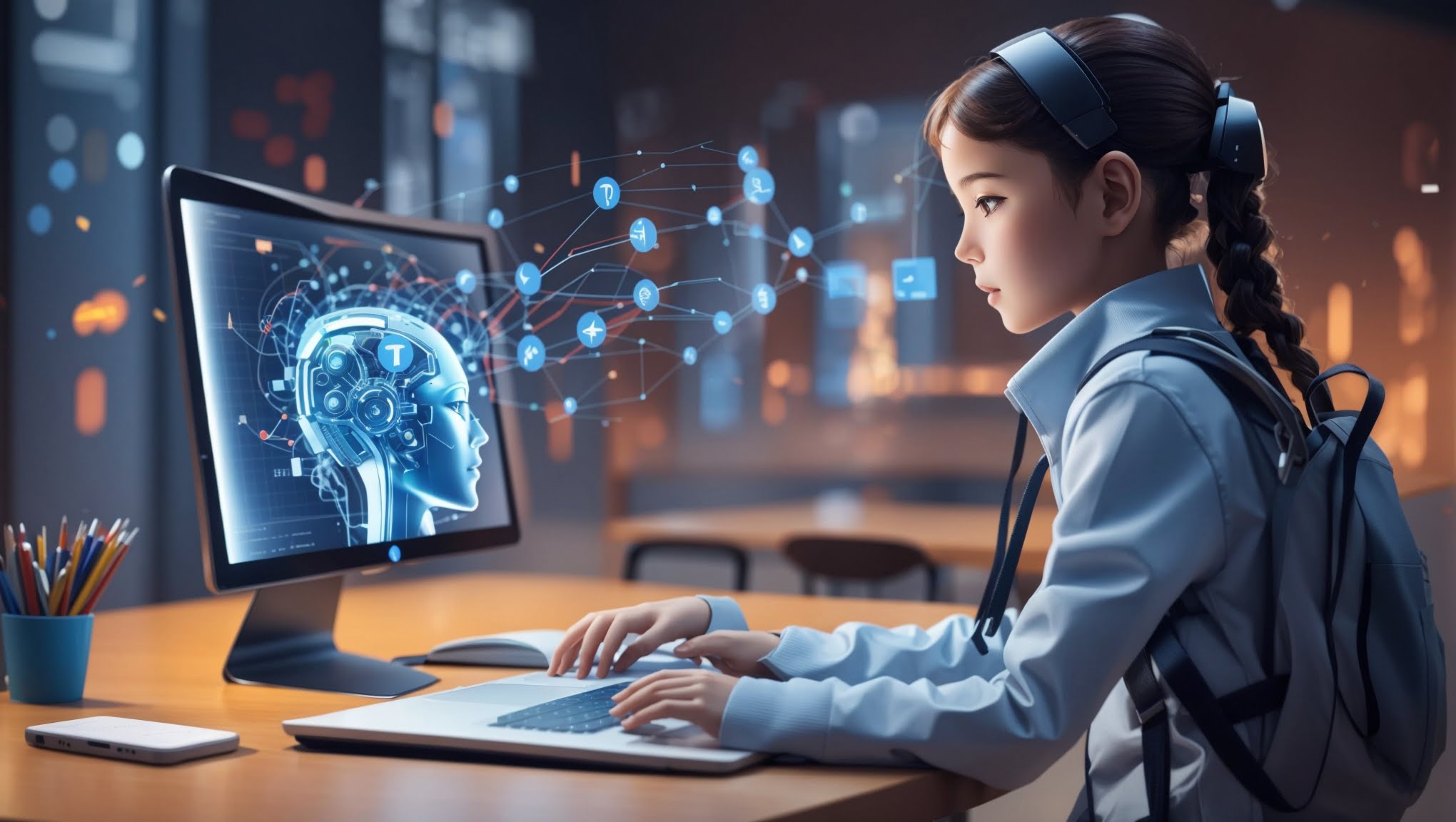
🔮 8 Predictions of the Future of AI in Education
We have surveyed teachers worldwide based on their experiences using AI and observations of classroom practices using AI, and combined them with insights from experts and education professionals. In the near future, educators can expect:
1. Multimodality to Continue Gaining Momentum
Multimodality is an enhancement of generative AI models, with the ability to “translate” content into various modalities, from text into images, images into videos, and text into audio, and so on. This increasing trend of multimodality in AI models will result in more exciting educational content being generated at a fast pace, and more engaging and comprehensive learning experiences, enabling students to grasp concepts more effectively through interactive and dynamic content.
2. Democratization of AI
With the indefinite rise of more AI tools, they will become more accessible and user-friendly, allowing educators from all backgrounds to harness their potential in the classroom. AI will be embraced as part of teaching and learning experiences in classrooms worldwide, to automate administrative tasks, personalize learning experiences, offer timely feedback, and promote student engagement.
3. Greater Focus on Social-Emotional and Human-Centered Teaching
As teachers embrace AI in their teaching journeys, there will be an increasing emphasis on the importance of social-emotional skills development among students. Teachers will not be able to fully rely on AI on all aspects of student development, and social-emotional and human-centered teaching is something that only human teachers are well qualified to provide.
4. Personalized Learning at Scale
One of the greatest strengths of AI is its ability to personalize learning AI quickly and easily. With this rising trend of AI adoption in education, we are expected to see adaptive AI algorithms to continuously revolutionize personalized learning, tailoring educational pathways to each student’s unique strengths, weaknesses, and learning pace, and catering to diverse learning needs at scale.
5. Less Time Spent on Lesson Planning, and More on Teaching
Of course, with the emergence of more and more AI tools on various aspects of teaching and learning, these tools will streamline and automate lesson planning, content creation, and assessment tasks. This shift will empower educators to instructional delivery and individualized support, fostering deeper student engagement and understanding.
6. Enhanced Self-Directed Learning
Just as how AI revolutionizes the way teachers teach, similarly, AI has revolutionized the way students learn. AI chatbots like Socratic by Google and ChatGPT (see example #72) are already empowering students in their self-directed learning journeys with personalized learning recommendations and guidance. And teachers can expect this trend to rise.
7. More Accessible and Inclusive Learning
AI technologies will continue to advance accessibility in education, making learning materials and resources more inclusive for students with diverse needs. AI will support closed captions, text-to-speech, and other assistive technologies, ensuring that every learner can access and engage with the content effectively.
8. Augmented Reality (AR) and Virtual Reality (VR) Educational Experiences to Take the Stage
The integration of AR and VR in education will become more prevalent, providing immersive and interactive learning experiences to students. And AI plays a significant role in enhancing AR and VR educational experiences through enabling voice interactions with AR and VR applications, the creation of AR and VR educational content through multimodality (i.e., converting text-based materials into 3D models or simulations), and more, resulting in more engaging and lifelike simulation experiences.
Did you know you can use ChatGPT for VR tours, lab simulations, or field trips? Read example #31 in this list of 100+ ChatGPT examples for teachers.
📖 Summary: The future of AI in education promises a transformational shift in teaching and learning practices. It will empower teachers to be more effective educators, cater to individual student needs, and create inclusive and engaging learning environments, ultimately enhancing the overall educational experience for students.
Final Thoughts
As AI holds the potential to revolutionize teaching and learning, we recognize the mixture of hopes and concern among educators. With our guide, we address various anxieties teachers have regarding the use of AI by providing actionable insights, the best AI tools for teachers, as well as real-world examples and future predictions of AI. So, make full use of this guide to equip yourself with the information and tips, harness the potential of AI, and better prepare yourself for the future of AI in education!
We hope you are now ready to put on your future-ready suit, to embark on a journey to create a one-of-its-kind classroom teaching experience, and be the frontrunner of AI in education. Save this guide and share it with others to inspire and empower more educators. Let us help one another pave an innovative, steady and open-minded future for the younger generation to come! 🚀
A-Z Guide to AI in Education 2024
Get access to the latest trends, tips, tools, and everything you need to know about AI in Education now.
